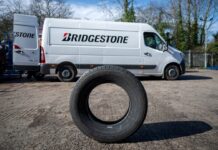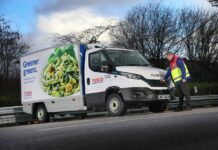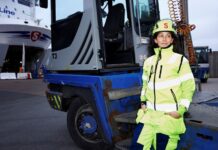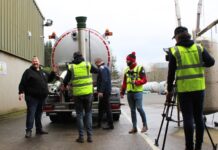Michelin is marking 100 years of retreading truck and bus tyres – with around 30 million worn tyres given a new lease of life at the Michelin plants in Stole-on-Trent, UK and Homburg, Germany.
That’s 30 million fewer tyres that had to be recycled in the region, corresponding to 1.5 million tonnes of raw materials saved and almost 3.5 million tonnes of CO2 that hasn’t been polluting the environment. This demonstrates the tangible environmental benefits of retreading truck and bus tyres.
“Retreading is a more sustainable and environmentally friendly process than new tyre production and an integral part of Michelin’s offering for haulage companies, own-account operators and both coach and bus fleets. Our customers expect economical solutions that result in cost savings and support them in making their contribution to sustainable transport. Retreading, together with regrooving, delivers this and more,” says Andrew French, B2B Sales Director at Michelin Tyre plc.
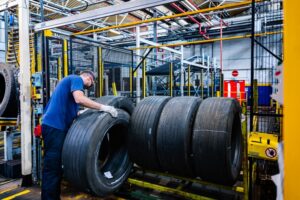 Since the company was established, Michelin has contributed to advances in mobility with numerous innovations, especially in the road transport industry. As early as 1923, Michelin began to offer retread truck tyres, setting a precedent for its focus on sustainability. This allowed the company to extend the service life of its tyres – leading to greater conservation of resources and lower costs for customers. Thanks to their quality, Michelin tyres were also easier to repair and retread.
Since the company was established, Michelin has contributed to advances in mobility with numerous innovations, especially in the road transport industry. As early as 1923, Michelin began to offer retread truck tyres, setting a precedent for its focus on sustainability. This allowed the company to extend the service life of its tyres – leading to greater conservation of resources and lower costs for customers. Thanks to their quality, Michelin tyres were also easier to repair and retread.
The next major innovation followed in 1930 with Michelin Metallic: instead of textile layers, the company used metal layers in its heavy vehicle tyres, which were much more resistant to damage. And, thanks to their more robust design, they were suitable for retreading up to three times.
With the invention of the radial tyre, Michelin set a new standard in terms of durability, safety and fuel economy for tyres at the end of the 1940s.
In the following years, Michelin adapted it for trucks and buses. 20 years later, the company developed the Michelin Remix process – with the Remix name standing for REmould, MIchelin, Radial, with the X being used by Michelin as the official designation for a radial tyre.
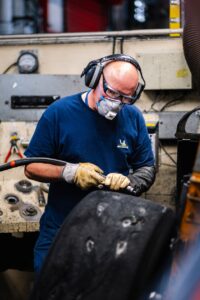 This makes it possible to renew the tread with the same Michelin materials, technologies and manufacturing processes as in the production of new tyres. The Michelin Remix process also follows the original design – meaning a Michelin Remix tyre delivers the same performance in terms of safety, traction and grip – another breakthrough.
This makes it possible to renew the tread with the same Michelin materials, technologies and manufacturing processes as in the production of new tyres. The Michelin Remix process also follows the original design – meaning a Michelin Remix tyre delivers the same performance in terms of safety, traction and grip – another breakthrough.
Demand for retread tyres continued to increase, leading to the expansion of production to the Stoke-on-Trent plant in 1968.
Environmental savings
Retreading delivers tangible environmental savings during manufacturing, helping to conserve valuable raw material resources.
On average, only 20 kg of raw materials need to be added to the casing to manufacture a Michelin Remix tyre, compared with a new tyre which requires around 70 kg of materials. This means that a retread truck or bus tyre consumes up to 70 per cent fewer raw materials than a new tyre.
Extrapolated to 100 retread tyres, this means a saving of up to five tonnes of raw materials and more than six tonnes fewer CO2 emissions.
Michelin truck and bus casings are designed from the outset to have multiple lives in service and to be retread at least once. Nevertheless, every tyre is subjected to a strict inspection and verification process by skilled professionals before the retread process begins.
All casings pass through a visual, tactile and X-ray inspection process upon arrival at the factory, a further shearographic inspection of the casing surface.
Up to 90 per cent of Michelin truck and bus tyres delivered for retreading meet the criteria of the initial inspection. Whether or not the tyre has been regrooved has no impact on its acceptance for retreading.
After this verification, preparation and machining, the casings receive new treads and sidewalls before being cured for around 90 minutes in a mould at temperatures of up to 200 degrees Celsius, which gives them their final tread pattern. The amount of rubber and the quality of the mixtures are identical to those used to make new tyres, guaranteeing a constant thickness of rubber between the bottom of the tread pattern and the protective layers.
Finally, after being remanufactured, all tyres are subject to a final quality inspection which involves inflation to 140psi to confirm the product’s integrity. Tyres which have had any casing repairs carried out also go through a secondary test, which sees 50,000 Volts passed through the tyre to detect any penetrations to the casing.




